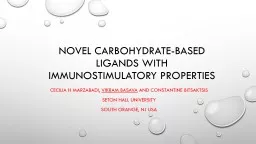

Immunostimulatory Properties Cecilia H Marzabadi Vikram Basava and Constantine Bitsaktsis Seton Hall University South Orange NJ USA Introduction The zwitterionic polysaccharide PSA1 isolated from the capsule of ID: 779775
Download The PPT/PDF document "Novel Carbohydrate-based Ligands with" is the property of its rightful owner. Permission is granted to download and print the materials on this web site for personal, non-commercial use only, and to display it on your personal computer provided you do not modify the materials and that you retain all copyright notices contained in the materials. By downloading content from our website, you accept the terms of this agreement.
Slide1
Novel Carbohydrate-based Ligands with Immunostimulatory Properties
Cecilia H Marzabadi,
Vikram
Basava
and Constantine
Bitsaktsis
Seton Hall University
South Orange, NJ USA
Slide2Introduction
The
zwitterionic
polysaccharide, PSA1, isolated from the capsule of Bacteroides fragilis, has been shown to stimulate both innate and adaptive immune responses in mammals and is believed to be important in establishing a balanced immune system which is mediated by T-lymphocytes.
1
2
Slide3INtroduction
Work in our laboratory involves the synthesis of simpler
zwitterionic
saccharide analogues for evaluation as potential stimulants of innate and/or adaptive immunity.Recently, One such
analog, 2, has been synthesized and has been shown to possess
immunostimulatory properties.
2
3
Slide4Synthesis of Subunit A:
(Proposed Scheme)
Synthetic
STUdies
4
Slide5ORTEP representation
of the anhydride
3,6-Anhydride molecules showing intermolecular H-bonding
Synthetic
STUdies
5
Slide6Synthetic
STUdies
Reactivity of 3,6-Anhydro-
D
-glucal:
6
Slide7Reactivity of 3,6-Anhydro-
D
-glucal:
Synthetic
STUdies
7
Slide88
Slide9Synthetic STUdies
Synthesis of Subunit A:
9
Slide10Synthetic studies
Synthesis of Subunit B:
B
10
Slide11Synthetic studies
Synthesis of Subunit C:
11
Slide12Synthetic studies
Synthesis of Subunit C (
cont
):C
12
Slide13Synthetic studies
Coupling of Subunits A and B:
13
Slide14Synthetic studies
Coupling of Subunit A+B with C:
14
Slide15BIOLogical Evaluation
Protected
analog
2 wa
s
evaluated in ELISA assays for the production of the
proinflammatory
cytokines TNF-
a
and IL-6 using Raw 264.7 and mouse peritoneal macrophages (C57 BL/6, Jackson
)
Innate Immunity:
15
Slide16BIOLogical Evaluation
Tnf
-
a
Innate Immunity:
16
Slide17BIOLogical Evaluation
IL-6
Innate Immunity:
17
Slide18BIOLOGICAL EVALUATION
The molecule synthesized was also tested in spleen cells from the same mice looking for T and B cell proliferation, levels of
IFN-
g in the supernatants (indicative of a T cell response), and polyclonal IgM and IgG levels in the supernatants l (indicative of a B cell response) were Measured.
No T Cell or B Cell responses were observed.
Adaptive Immunity:
18
Slide19BIOLOGICAL EVALUATION
To elucidate the bacterial Toll Like Receptor responsible for cytokine production, the peritoneal macrophages from TLR2 and TLR4 knockout mice (female, 4-6 week old C57BL6) were dosed with compound
2
and, tnf-a and IL6 levels were measured overtime in the supernatents.
Innate Immunity: TLR2 vs TLR4 Ligand19
Slide20BIOLOGICAL EVALUATION
TLR KO MICE: TNF-
a
Production20
Slide21BIOLOGICAL EVALUATION
TLR KO MICE: IL-6 Production
21
Slide22the extent of binding of analogue
2
to the TLR-4 receptors was illustrated by treating the peritoneal exudate cells (pec) with different concentrations of the compound. The cells were pre-incubated with the compound, after which were washed. To the washed cells was added the antibody followed by the
phytoerythrin dye and, the number of the coloured cells was observed by flow cytometry.
TLR-4 EXPRESSION: Flow Cytometry
BIOLOGICAL EVALUATION22
Slide23BIOLOGICAL EVALUATION
TLR-4 EXPRESSION: Flow Cytometry
23
TLR-4
Slide24BIOLOGICAL EVALUATION
TLR-4 EXPRESSION: Flow Cytometry
24
Slide25BIOLOGICAL EVALUATION
TLR-2 EXPRESSION: Flow Cytometry
25
Slide26BIOLOGICAL EVALUATION
A reduction in the production of both TNF-a and IL-6 was observed in only the TLR4 knockout mice suggesting that signaling of
2
occurs through TLR4. Furthermore, the magnitude of TLR4 signaling with 2 was greater than the known TLR4 AGONist,
e. coli LPS (LIPOPOLYsaccharide)
SUMMARY: TLR KO MICE
26
Slide27Conclusions
The desired
zwitterionic
polysaccharide, an analogue of psa1, was successfully synthesized with both amino and carboxylate moietiesThe biological evaluation clearly denotes that the analogue 2 shows immunostimulatory properties Analogue
2 was found to stimulate the innate immune system, and not the adaptive immune systeman unexpected and an efficient synthesis of 3, 6-anhydro-
d-glucal paves a route to the synthesis of interesting new carbohydrate moieties
27